Art
Space Tourism Posters
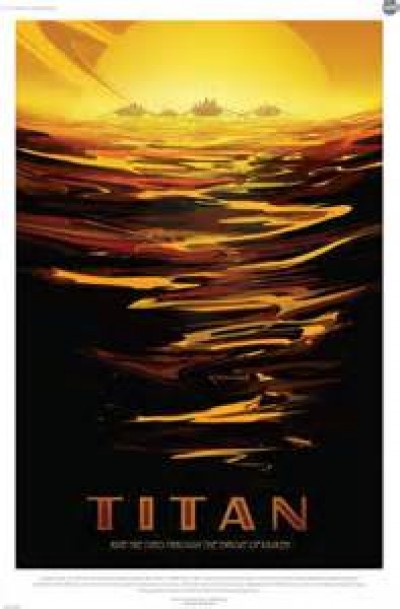
NASA is giving away space tourism posters. NASA had the posters designed, presumably to encourage continued interest in the space program. Whatever the purpose, the posters are very cool. Check them all out at the link.
Posted By: Alex - Mon Feb 15, 2016 -
Comments (8)
Category: Art, Spaceflight, Astronautics, and Astronomy, Graphics
Moldy Fashion
May 1999: Belgian fashion designer Maison Martin Margiela had a fashion/art exhibition at the Brooklyn Anchorage gallery in New York City in which he displayed his latest creation — mold-covered clothes. Reported Time: "The clothes were dipped in agar and treated with mold, bacteria and yeast; they were then left to develop new colors and textures (the smell is a bonus)."In fairness to Martin Margiela, this was more art than fashion show. According to art historian Ingrid Loschek, the display "compared the natural cycle of creation and decay to the consumer cycle of buying and discarding."
The moldy clothes were burned at the end of the exhibition, since they were in such an advanced stage of decomposition that they were unfit for anyone to wear.
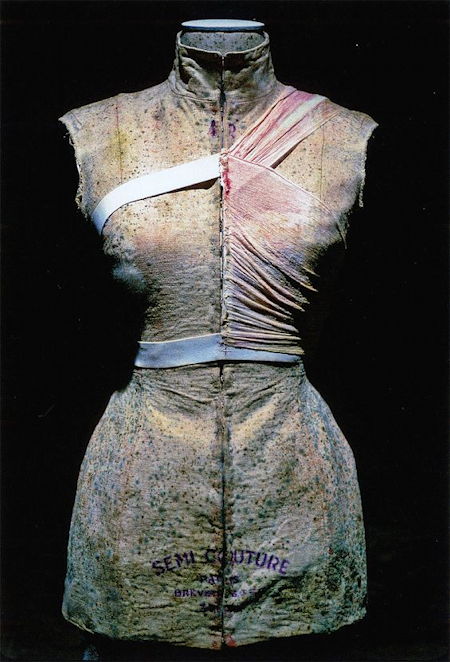
via pinterest
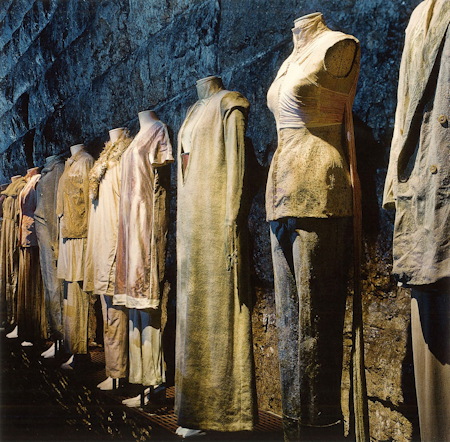
via Slow and Steady Wins the Race
Posted By: Alex - Wed Jan 27, 2016 -
Comments (9)
Category: Art, Fashion, 1990s
Horse on a bean bag?

The title of this work is "Moje Sabz." It was created by Iranian-born artist Soheila Sokhanvari, and is currently on display at the Champagne Life exhibition in London, which is a showcase of art by women.
So what exactly is going on in the piece? Is it a horse on a bean bag? A horse with an airbag? The Saatchi Gallery explains that it's actually about "the ‘Green Movement’ uprising of 2009 [in Iran], in which violent protesters’ demonstrations lead to the annulment of a fraudulent election result."
Well, now that's pointed out, it's obvious really.
[For the record, I would LOVE to have this piece on display in my living room, though a) I couldn't afford it, and b) my wife would divorce me if I did.]
Posted By: Alex - Thu Jan 14, 2016 -
Comments (9)
Category: Art
Universal Colorblindness Test
New stuff from artist Jonathon Keats. He's developed what he calls a "Universal Colorblindness Test," which combines the standard colorblindness test with the new fad for adult coloring books.He describes it as the first colorblindness test that will "adapt to each viewer’s eyesight as the viewer colors them in." He adds, "My test is the first to internalize chromatic subjectivity, ensuring equally positive test results for everybody.”
Available at Walls360.


Posted By: Alex - Wed Jan 13, 2016 -
Comments (4)
Category: Art, Eyes and Vision
Art of Erasure
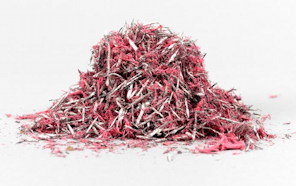
In her "Dictionaries" series she uses an eraser to "rub away aggressively" at words and printed definitions. (For instance, she has erased the words "white," "yellow," and "black" from old Webster's dictionaries to create "colorblind dictionaries.")
And her erasure sculptures "are made from the eraser residue, which she gathers into modest piles."
Info source: Blouin Art Info. Also check out Collins' website. Her older work appears to be more traditional charcoal and pastel sketches.
Posted By: Alex - Sun Dec 20, 2015 -
Comments (5)
Category: Art
Gang Member Rugs
Created by artist Renato Garza Cervera out of leather, polyester, polyurethane foam, glass eyes, and paint. Cervera explains that rugs used to represent fierce creatures such as lions, tigers, or bears. So he decided to create rugs that show fierce creatures with more contemporary relevance.He goes on to say that his rugs represent "Calibanization" (as in, the character Caliban from Shakespeare's The Tempest). "It's an aesthetic consideration of collective political, social and psychological mechanisms and patterns." More info: MySanAntonio.com.


Posted By: Alex - Sat Nov 28, 2015 -
Comments (7)
Category: Art, Furniture
Trumpkins
Donald Trump has become the theme of Halloween this year. People everywhere are creating pumpkins, aka Trumpkins, in his likeness. Some examples: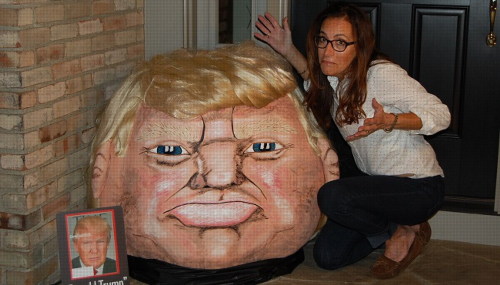
A 374-pound Trumpkin created by Jeanette Paras of Dublin, Ohio. wbtw.com
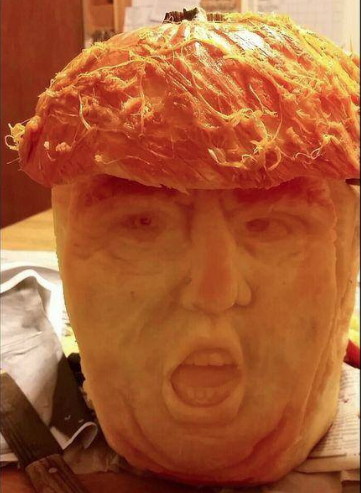
by Nancy Faber, via Twitter

by billybush, via Instagram
Posted By: Alex - Wed Oct 28, 2015 -
Comments (5)
Category: Art, Holidays, Politics
Canned Parrot
A soon-to-be-opened San Francisco store called Terrific Street is displaying cans of "canned parrot" in its front window. Two kinds of canned parrot are on display — "free range cherry conures in their own syrup" and "colorful sky rat boiled parrot."The store isn't actually selling canned parrot. The owner of the store has explained that the display is an "art installment" inspired by Andy Warhol's paintings of canned food, while also referring to the local wild parrot population.
Says the owner: "The thinking behind the display was to make something unusual and fun for folks to walk by between now and the time we are open for business."
More info: SFGate.com



Posted By: Alex - Wed Oct 21, 2015 -
Comments (8)
Category: Animals, Art, Food
Rat Art
March 1975: Dr. Richard Cimbalo of Rosary Hill College (now Daemen College) held an exhibition of "rat art" in order to raise money for the school's psychology department. "The rats painted by grabbing with their front paws a brush extended into their cages, and Cimbalo said each of the artists had its own style."I wonder what became of this rat art. Probably stored away in a box in someone's attic. Or tossed out.
Someone should open a Museum of Animal Art — to collect together in one place all the paintings by rats, chimpanzees, elephants, etc. that have been produced over the years.

The Desert Sun (Palm Springs, CA) - May 12, 1975
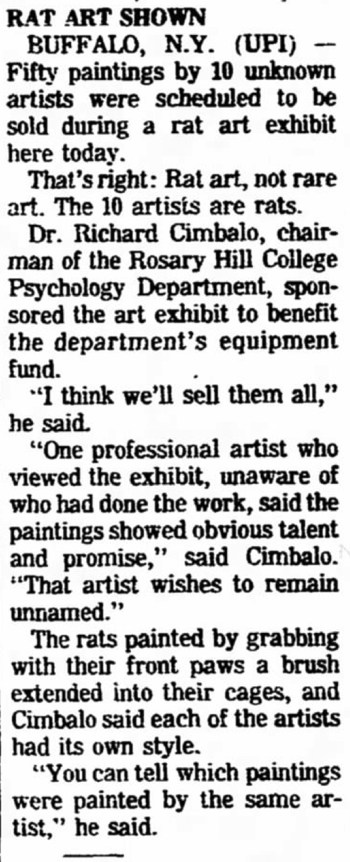
The Daily Courier (Connellsville, PA) - Mar 15, 1975
Posted By: Alex - Tue Oct 20, 2015 -
Comments (3)
Category: Animals, Art, 1970s
Postmortem Tattoo Preservation
The National Association for the Preservation of Skin Art recently launched. Its mission is to preserve the tattoos of any of its members who have died. They claim they have a "new proprietary process" of preservation which helps them to do this.Of course, to preserve the tattoo, it first has to be removed. The Association doesn't send someone out to do this. Instead, they ship a kit to the funeral home and have them do it. The end result is a nicely framed piece of tattooed human skin.
We've discussed postmortem tattoo preservation before here on WU. For instance, we've noted that as far back as 1950 the Imperial University of Tokyo was collecting tattooed skins. And more recently, tattoo enthusiast Geoff Ostling bequeathed his skin to the National Gallery in Canberra.

Posted By: Alex - Wed Oct 07, 2015 -
Comments (10)
Category: Art, Death, Skin and Skin Conditions

| Who We Are |
|---|
| Alex Boese Alex is the creator and curator of the Museum of Hoaxes. He's also the author of various weird, non-fiction, science-themed books such as Elephants on Acid and Psychedelic Apes. Paul Di Filippo Paul has been paid to put weird ideas into fictional form for over thirty years, in his career as a noted science fiction writer. He has recently begun blogging on many curious topics with three fellow writers at The Inferior 4+1. Contact Us |




